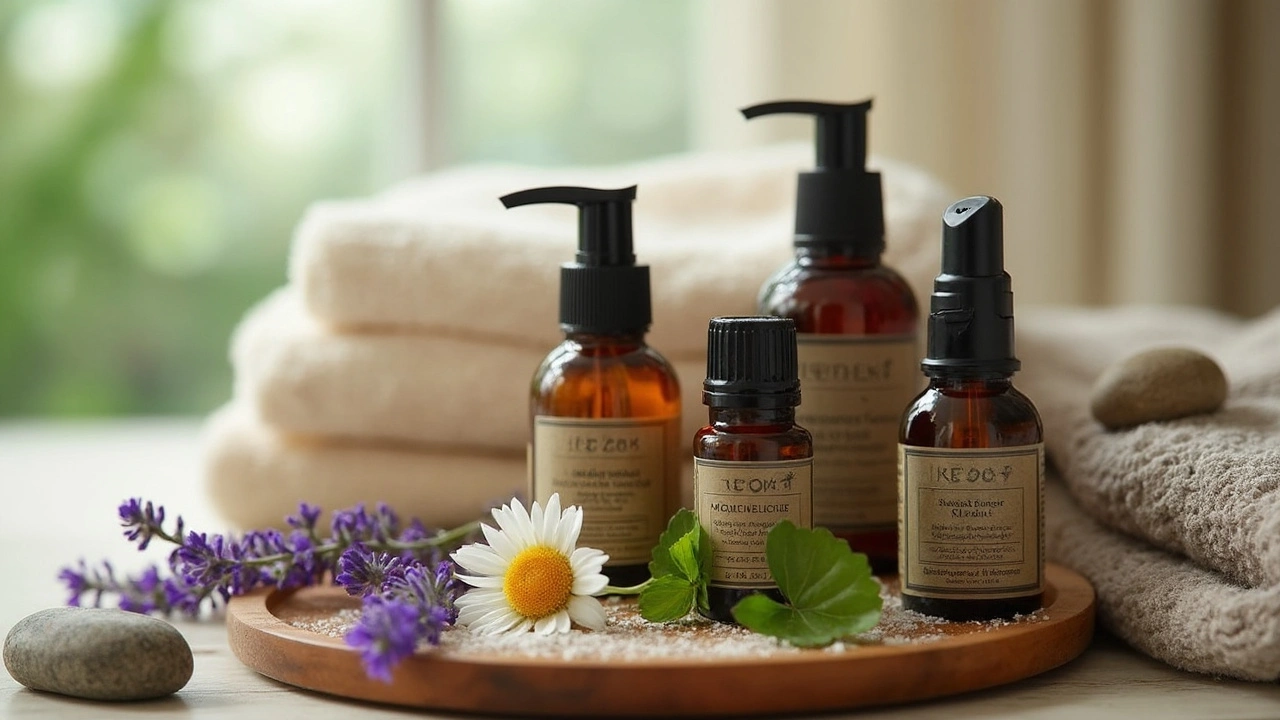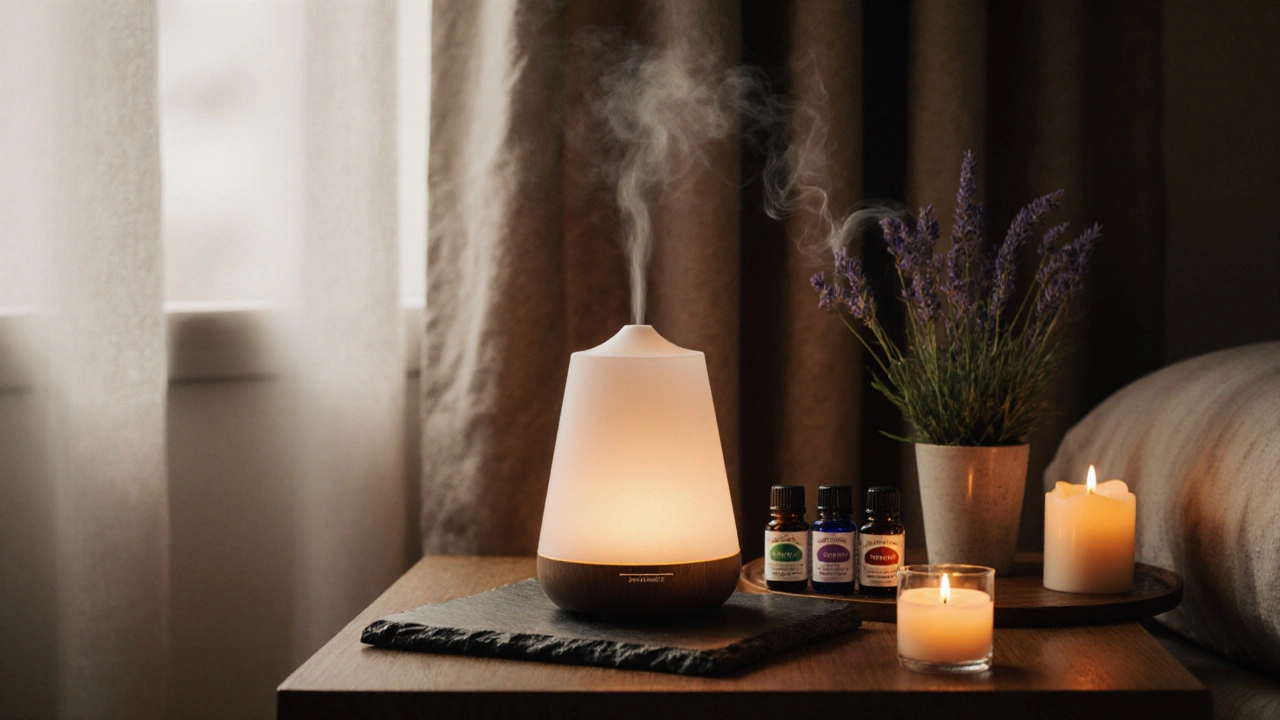Learn the basics of aromatherapy massage: benefits, essential oil selection, beginner routine, safety tips, and how to find certified therapists.

- Created by: Archer Caldwell
- Completed on: 29 Jun 2025
- Categories: Wellness
Ever wondered why your friend can’t stop raving about their last aromatherapy massage? There’s something about it that sticks in your mind—maybe it’s the sweet scent hovering in the room, the gentle pressure of hands gliding over tense muscles, or the way every worry seems to melt away afterward. The real secret? Aromatherapy doesn’t just add a nice smell—it creates a whole new layer to the massage experience, making it richer, deeper, and honestly, kind of addictive. So what’s really going on when you combine touch with the right scents?
Key Points
- Aromatherapy massage blends essential oils with massage therapy for enhanced relaxation and wellness.
- Common oils like lavender, eucalyptus, and peppermint each offer unique physical and emotional benefits.
- Getting the most from your session depends on oil choice, communication with your therapist, and environment.
- Proper safety tips ensure a soothing, allergy-free experience.
- Prices vary, but knowing what to expect helps you book confidently and avoid upcharges.
Direct Answer
So, here’s the quick version: Aromatherapy isn’t just about making the room smell good. By blending specific essential oils with massage, you get boosted relaxation, quicker stress relief, and even targeted benefits (think: muscle tension, sinus stuffiness, or mental fuzziness). It elevates regular massage sessions into a customized relaxation experience that benefits your body and mood. Your therapist usually personalizes oil blends, so you walk away feeling like the whole treatment was made just for you.
Comprehensive Guide to Aromatherapy in Body Massage
If you’ve ever stepped into a spa and been instantly relaxed by a wave of citrus or lavender, you’ve brushed shoulders with the power of aromatherapy. Aromatherapy started becoming popular in massage around the 1980s, but this isn’t some New Age fad. Egyptians used plant oils for medicine and rituals over four thousand years ago. Today, massage therapists add a few carefully chosen drops of essential oils to their carrier oil—often sweet almond or grapeseed—then work it into your skin as they massage. The scents rise up with each stroke, filling your senses while the oils work topically to soothe soreness or calm skin. But here’s the kicker: it’s not just what you smell. Aromatherapy also works with your body chemistry. As your skin absorbs the oil, the effects can actually reach deeper tissue and even influence your nervous system.
Picture this: You’re on the table, the lights are low, the music’s soft—and your therapist asks, “What kind of mood are you looking for?” With the right combo of oils, you can dial up energy for a midday reboot, clear your head during allergy season, or knock yourself out for the best nap you’ve had in weeks. Studies show that as little as fifteen minutes of aromatherapy can lower cortisol (that’s your stress hormone) by up to 31%. That’s not wishful thinking. And it’s why high-stress professionals or athletes often turn to these treatments for real recovery, not just pampering. Try it after a week of overtime or before a big event and you’ll see what I mean—your mind actually feels cleaner, and your muscles recover faster.
Definition and Context of Aromatherapy in Massage
Let’s get clear: Aromatherapy massage is a specialized treatment that merges two things your body craves—therapeutic touch and plant-based essential oils. The massage part ramps up circulation, eases knots, and pushes toxins out. The aromatherapy element taps into your limbic system, that part of your brain tied to memory and emotion. It’s why one sniff of lemon can yank you back to grandma’s kitchen, or lavender wipes away your edge of anxiety.
Essential oils aren’t just random scented stuff, though. They’re concentrated plant extracts—each with a unique molecular makeup that affects you in different ways. Lavender, for instance, is famous for relaxation, while peppermint wakes up your mind and cools down inflammation. When you pair the right oil with your mood or body’s needs, you feel it instantly. The massage therapist will blend the oil into a carrier (since essential oils are too potent to apply directly), then use classic techniques—Swedish, deep tissue, or even shiatsu—with aromas tailored to what you want. Maybe you’re looking for deep relaxation, relief from sore muscles, or a clear mind before an exam or interview. Aromatherapy can help target those specific goals, making your massage feel like it was designed just for you.
If you’re worried about it being “too out there,” you should know many mainstream clinics and luxury spas now offer aromatherapy as a standard extra. And there’s legitimate research to back it up. In 2022, a study published in The Journal of Alternative and Complementary Medicine found people who got regular aromatherapy massages reported less chronic pain, tension headaches, and stress than those who just got massage alone. The science makes sense—essential oils can travel through the skin barrier, hit your bloodstream, and influence everything from your heart rate to your sleep quality.
Benefits of Aromatherapy Massage
Time for the real-world perks. Aromatherapy massage isn’t just some spa up-sell; it delivers measurable benefits for both your body and your mind. Anxiety, insomnia, tension headaches, muscle pain—these are just a few issues folks say improve after sessions. If you’re recovering from a tough workout, oils like marjoram or rosemary can decrease muscle soreness faster. Had a stressful week? Almost everyone loves the calming hit of ylang-ylang or lavender. Allergies and sinus issues? Eucalyptus and peppermint open up clogged airways so you breathe easier (big plus if you have hay fever).
But it goes deeper than that. Regular aromatherapy massage sessions have been shown to lower blood pressure and heart rate—no surprise given how these oils hit your nervous system. Some people even use them to manage symptoms from chronic illnesses. For folks with fibromyalgia, gentle massage with sandalwood or chamomile can make a dramatic dent in pain levels. One striking anecdote: In a 2023 survey of massage clinic clients, almost 78% credited aromatherapy with “lasting improvement” in mood and stress levels (compared to 59% for massage alone). If you’re curious about the numbers, here’s a quick look at what people report as real benefits:
| Benefit | Aromatherapy Massage (%) | Standard Massage (%) |
|---|---|---|
| Deep relaxation | 87 | 66 |
| Reduced muscle pain | 73 | 65 |
| Improved sleep | 65 | 39 |
| Reduced anxiety | 82 | 55 |
| Better mood (24 hours after) | 90 | 61 |
Want to maximize these perks? Ask your therapist about personalizing your oil blend based on how you’re feeling that day. And if you’re new, start with a simple trio: lavender for relaxation, eucalyptus for clarity, and rose for emotional uplift. Once you know what works for you, you can tailor sessions for energy, stress, pain, or sleep—whatever life’s tossing your way this week.
Types of Aromatherapy Massage Available
Not all aromatherapy massages are created equal. How do you know which one fits you best? It usually depends on technique, oil blends, and even the mood you’re chasing.
- Swedish Aromatherapy Massage: The classic choice. It’s all about gentle, flowing strokes using a blend of oils for either relaxation or energy (your call). Best for newbies or those wanting to turn their brain off.
- Deep Tissue Aromatherapy Massage: Perfect for athletes or anyone with stubborn muscle knots. Uses slow, forceful strokes with warming oils like ginger or muscular relief blends packed with rosemary and black pepper.
- Lymphatic Drainage Massage with Aromatherapy: Focuses on gentle, rhythmic movements and detoxifying oils like grapefruit, juniper, or lemon. Great if you’re feeling sluggish, puffy, or low-energy.
- Hot Stone Aromatherapy Massage: Heated stones plus grounding essential oils—think cedarwood, sandalwood, or vetiver. Delivers heat deeper while the scents root you in the moment.
- Reflexology with Aromatherapy: Oils are worked into your hands or feet, targeting specific pressure points tied to different organ systems. Popular if you’re short on time but still want the benefits.
Spas and clinics may also offer signature blends or seasonal treatments—like lemongrass to perk you up in winter, or peppermint for summer cooldowns. If you’re in a big city, you’ll probably see all the above options. Rural locations may stick to Swedish or deep tissue, but with more personalized blends. Remember: if you have allergies or sensitive skin, always let your therapist know before the session. They can swap out oils or go lighter to avoid irritation.

How to Find Aromatherapy Massage Services Near You
Okay, ready to book? You want a legit therapist, not some generic spa. Word-of-mouth recommendations work best—friends, coworkers, or even fitness trainers usually know the hidden gems. Online reviews help, but check for details about cleanliness, therapist training, and the oils they use (look for “pure essential oils,” not “fragrance oils”—the latter are synthetic and way less effective).
Most mid- to high-end spas now advertise whether they specialize in aromatherapy. Yoga studios sometimes offer combo packages (like yoga + massage + aromatherapy), which can be a real score. Big chains may have set blends, but indie clinics typically let you customize more. Some places now use digital tools—let you rate mood, stress, or sleep before your visit and suggest oils or blends for your appointment. Don’t just settle for the first ad you see. Ask if the staff includes certified aromatherapists; this extra layer means you’re getting someone who understands not just the scents but how your body responds.
Here’s a quick checklist for finding solid services:
- Check credentials: Massage therapists should have state licensing and, ideally, aromatherapy training.
- Look for transparency on oil quality: They should use 100% pure, therapeutic-grade essential oils—ask to see bottles if you want.
- Book a consult: During your first visit, staff should ask about allergies, medical history, and preferences.
- Ask about session range: Can you book 30, 60, or 90 minutes? Some offer upgrades like foot soaks or facial massage with aromatherapy.
- Get reviews from repeat clients: Consistency is a huge indicator of quality in this world.
What to Expect During an Aromatherapy Massage Session
The vibe starts before you even walk in. Good clinics pipe calming scents into waiting areas, but don’t be surprised if your therapist invites you to sample different oils before you strip down. They might ask what outcome you’re aiming for—relax, recharge, de-stress, recover. Once you pick your blend, expect a short consult about any allergies, injuries, or mood settings, so the treatment gets tailored to you.
During the massage itself, you’ll notice the difference almost instantly. Your therapist will warm the oil in their hands so you’re not jolted awake by cold liquid. The scent rises as they work the oil into your skin—a subtle, enveloping cloud that grows with each new muscle group. With essential oils like bergamot or frankincense, the effects hit fast. Your breathing slows, your shoulders drop, and you might even get emotional if the smell triggers a memory or feeling. That’s totally normal.
Most aromatherapy massages stick to Swedish techniques, but if you request deep tissue (or if you’re dealing with an injury), let your therapist know. They’ll tweak the oil blend to avoid anything that could irritate broken skin or inflamed tissue. A full-body session lasts anywhere from 60 to 90 minutes. Halfway through, you’ll probably lose track of time entirely. Many clinics provide warm towels soaked in essential oil-infused water, placed around your neck or over your eyes, boosting the sense of cocooning relaxation. By the end, the therapist will usually give you a few minutes to re-enter the world, sometimes offering chilled water or herbal tea to help metabolize any lingering toxins.
Don’t rush out! The lingering aroma keeps working even after you’ve gotten dressed. Some oils penetrate layers of skin and tissue and hang around your pulse points for up to an hour. That means more extended effects—calm, focus, clarity—that last well past your Uber ride home. It’s smart to let your skin absorb the oils—skip showering for at least a few hours afterward if you can.
Pricing and Booking Tips
No one likes sticker shock, so here’s the scoop: Aromatherapy massages typically cost 10–20% more than standard Swedish massage since you’re paying for those high-quality oils and the extra skill level of your therapist. Expect to pay around $90–130 for a 60-minute session in a mid-tier city. High-end spas in major metro areas can push up toward $200 an hour, but you’re often getting luxury extras—heated beds, custom blends, longer relaxation time before and after your treatment.
If you want to save, check for package deals or off-peak rates—Tuesday afternoons often have better pricing than weekends. Lots of places also have loyalty programs, offering every sixth or seventh massage free if you stick with them. When booking, be clear about allergies or scent sensitivity so you don’t end up out of pocket for a treatment you can’t enjoy. Always ask what's included—some places will include hot towels, scalp massage, or customized blends in the price, while others sneak in fees for every add-on. Avoid mobile or pop-up services unless you can confirm the therapist’s credentials and oil quality.
Online booking is now standard almost everywhere—many spas let you browse services, choose oils, and even set “treatment goals” when you schedule. Double-check the cancellation policy and whether tips are included (usually 15–20% is standard, but high-end places may build this into the final price). Remember: a good aromatherapy massage is an investment in both your body and mood, so don’t just chase the cheapest deal—look for experience, pure oils, and thoughtful extras that make the experience whole.
Safety Tips for Aromatherapy Massage
Most treatments are safe, but essential oils are powerful. Undiluted oils can irritate your skin—even classic favorites like tea tree or cinnamon. If you haven’t used a certain oil before, request a patch test first (therapists can dab a tiny bit on your inner arm and wait ten minutes to rule out reactions). Pregnant or nursing? Some oils—like rosemary, sage, or clary sage—should be avoided. Make sure your therapist knows. If you have asthma or allergies, try a sniff test away from your face to avoid triggering a reaction. Avoid direct oil blends on broken skin, eczema, or severe acne—use gentle options and carrier oils in these cases.
Be wary of super-cheap services or “fragrance oils,” which sound similar but are synthetic and can actually worsen headaches or cause breakouts. Pure, medical-grade essential oils are the gold standard. A real pro uses only a few drops per session, always diluted, to avoid overwhelming your system. If you’re on medication or have chronic health issues, ask your doctor before booking. And no matter how good it feels, don’t book back-to-back sessions—you can overdo it and shock your nervous system.
Listen to your body. If you start to feel dizzy, itchy, or uncomfortable at any point, tell your therapist right away. Most want you to relax, not tough it out. And after your massage, drink plenty of water to help your body process the oils and flush out any built-up toxins released during deep muscle work.
Comparison Table: Aromatherapy Massage vs. Standard Massage
| Feature | Aromatherapy Massage | Standard Massage |
|---|---|---|
| Scents used | Yes (essential oils) | No |
| Customizable mood effects | Yes—energy, relaxation, focus, etc. | Limited |
| Skin & tissue benefits | Yes—depends on oil blend | Standard benefits |
| Pricing | 10–20% higher | Base rate |
| Duration | Usually 60–90 minutes | 60–90 minutes |
| Allergy concerns | Potential (from oils or botanicals) | Minimal |
| Stress reduction stats | Up to 31% cortisol reduction | About 10–15% cortisol reduction |
| Afterglow effect | Often lingers up to 24 hours | Shorter (a few hours) |
FAQ: Your Questions About Aromatherapy Massage Answered
- Is aromatherapy safe for everyone? Most people have no issues, but if you're pregnant, nursing, or have allergies/asthma, let your therapist know for tailored blends.
- What’s the best essential oil for beginners? Lavender and sweet orange are universally loved and gentle on sensitive skin.
- How long do the effects last? Most people feel relaxed and uplifted for at least 12–24 hours post-session.
- Will my skin feel oily afterward? Therapists blend essential oils into light carrier oils, so you shouldn't leave feeling greasy. Let the oils absorb for max benefit.
- Can I pick my own blend? Absolutely! Many spas let you sample options or suggest combos based on your goals.
- How often should I get an aromatherapy massage? Once or twice a month is typical for general wellness, but more often for targeted issues—chat with your therapist.
- Is it OK to shower right after? Try to wait a few hours so your body fully absorbs the oils and you don't wash away the benefits.
Ready for that break your body’s been begging for? Book your aromatherapy massage and see firsthand why it’s the ultimate combo of scent, touch, and total relaxation.
Discover how aromatherapy transforms your body massage experience—boosting relaxation and rejuvenation. Learn essential oil tips, session expectations, pricing, and more.
Aromatherapy massage combines skilled touch with calming essential oils to reduce stress, improve sleep, and ease muscle tension. Discover how this holistic therapy delivers real wellness benefits backed by science and real user experiences.



danny henzani
July 2, 2025 AT 16:14Ugh, aromatherapy massage? I mean, come on, is this just another luxury fad or does it actually do anything? People throw around words like 'rejuvenation' and 'boosting relaxation' but where's the concrete science behind this? Just smells and oils don't magically fix stress or muscle problems.
I've always been skeptical about these holistic approaches; they sound like pseudoscience dressed up with fancy words. Don’t get me wrong, a massage feels good, but the whole aromatherapy angle smells like selling snake oil to me. Can someone explain how some essential oils are supposed to physically enhance a massage beyond placebo?
Oh, and pricing! These places charge a premium just because they toss in some lavender and call it aromatherapy. Question is, how much of that cost reflects actual therapeutic benefits versus pure marketing hype?
Emily Martin
July 3, 2025 AT 20:01I totally get the skepticism, but aromatherapy massage can really enhance relaxation on multiple levels. The scents from essential oils can stimulate the limbic system in our brain, which influences emotions and memories. This can help reduce stress and anxiety more effectively than a plain massage.
That said, I always recommend checking if a therapist uses high-quality, reputable essential oils. Not all oils are created equal and some can have adverse effects if misused. But when done properly, it can be a gentle, natural method to boost both mind and body wellness.
And yes, the pricing might seem steep, but you’re often paying for expert knowledge and the calming environment as much as the oils themselves.
aidan bottenberg
July 6, 2025 AT 03:34This discussion about aromatherapy massage brings an interesting point regarding its physiological impact, which is often overlooked. The application of essential oils combined with massage techniques may induce parasympathetic nervous system activation, thereby promoting relaxation and reducing cortisol levels.
Empirical studies on aromatherapy remain limited yet promising; certain oils like lavender have been demonstrated to possess anxiolytic properties. However, treatment efficacy is also contingent on individual receptor sensitivities and psychological expectations.
Price variability likewise reflects differing levels of service, oil purity, and practitioner expertise. Thus, a higher price point does not inherently guarantee superior results.
Grace Nean
July 8, 2025 AT 11:08Hey everyone! I think it’s really important to stay open-minded about complimentary therapies like aromatherapy massage, especially considering how stressful modern life can be. Aromatherapy added to massage creates a multisensory experience that can soothe not only the body but layers of emotional tension, too.
From what I’ve seen, many cultures have embraced the benefits of essential oils for centuries, blending them with physical therapies. This isn’t just a passing trend; it's rooted in tradition and holistic well-being.
If you're curious but unsure, try a session with a certified practitioner who respects your preferences. It might surprise you how refreshed and balanced you feel afterward.
Tejas Kalsait
July 10, 2025 AT 18:41In the paradigm of integrative therapeutic modalities, aromatherapy massage constitutes a fascinating confluence of neurophysiology and phytochemistry. The olfactory stimuli triggered by volatile compounds in essential oils potentially catalyze neurohormonal cascades that mediate autonomic balance.
This axis between tactile stimulation and olfactory signaling may potentiate homeostatic restoration beyond mere mechanical intervention. Nonetheless, robust randomized controlled trials remain requisite to delineate specific dose-response correlations and standardize efficacious protocols.
Consequently, engagement with such modalities ought to be contextualized within evidence-based frameworks alongside personalized patient profiles.
Rahul Verma
July 15, 2025 AT 09:48Appreciate the detailed insights here! From a more relaxed standpoint, I think the beauty of aromatherapy massage is how it invites us to slow down and mindfully connect with our bodies. The essential oils aren’t just smells; they act as gentle guides that can shift mood and calm the mind.
When I go for such massages, I find myself feeling lighter, less tangled in daily worries, and more grounded. Whether it’s the physiological effect or a comforting ritual, the benefits are real enough to me.
That being said, proper guidance and communication with the therapist are essential, especially if anyone has allergies or sensitivities.
John Galt
July 20, 2025 AT 00:54There’s an undeniable allure to aromatherapy massage as esoteric as that might sound. It taps into the age-old human quest for equilibrium—balancing somatic and psychic realms. Let’s not disregard that the brain’s chemical milieu responds dynamically to olfactory triggers, which in turn modifies psychophysiological states.
Yet one must approach this modality with critical acumen. Are we witnesses to tangible neurochemical shifts or sophisticated placebo effects dressed in fragrant garb? Clinical rigor must interrogate these claims.
Nevertheless, when integrated judiciously within broader therapeutic regimens, aromatherapy massage can enhance quality of life.
AMock Media
July 24, 2025 AT 16:01I can’t help but suspect that the aromatherapy industry capitalizes on consumer vulnerabilities, packaging common massage with exotic essential oils to upscale prices unfairly. It’s a cleverly manufactured niche that plays on the esoteric appeal and wellness culture hype.
Has anyone delved deep enough to scrutinize supplier transparency or the authenticity of therapeutic outcomes? It smells suspiciously like a profit-driven conspiracy blending wellness and luxury branding to me.
Still, admittedly, the psychological aspect of scent is powerful, but let’s not conflate subjective pleasure with medical efficacy.
Gail Maceren
July 29, 2025 AT 07:08It’s refreshing to read everyone’s perspectives. I just wanted to add that my own experience with aromatherapy massage has been consistently positive. It’s less about miraculous cures and more about creating a calming space where you can unwind.
Some essential oils have clearly soothing properties, and the combined touch therapy aids muscle tension. The key is to find therapists who prioritize your comfort and preferences.
Ultimately, it’s a wellness tool among many and its value varies individually. If you’re feeling curious, give it a go without expectations and see how your body and mind respond.